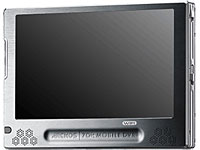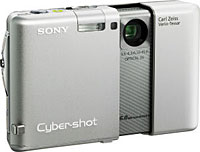 Digital camera heavyweights Sony have rolled out their first wireless Cyber-Shot digital camera, the 6-megapixel Cyber-shot DSC-G1.
Digital camera heavyweights Sony have rolled out their first wireless Cyber-Shot digital camera, the 6-megapixel Cyber-shot DSC-G1.
The G1 is Sony’s first wireless digicam able to send photos to other Digital Living Network Alliance (DLNA)-enabled devices (like other cameras and PCs) and Phil Lubell, director of marketing for digital cameras at Sony Electronics was ready to big up the technology: “This is a step towards realizing a platform for networked photo communication.”
“We will continue to explore the possibilities for networked digital imaging as broadband Internet becomes more pervasive in American homes,” he added.
The groundbreaking camera comes with a positively ginormous, 3.5-inch, 921k pixel screen, a whopping 2GB of internal storage, optical stabilisation and wireless connectivity.
 The metal bodied Cyber-shot model sports an eye catching design, with a Carl Zeiss 3x optical zoom lens (38-114mm, 35mm equiv) lurking behind a horizontally sliding cover.
The metal bodied Cyber-shot model sports an eye catching design, with a Carl Zeiss 3x optical zoom lens (38-114mm, 35mm equiv) lurking behind a horizontally sliding cover.
Socialites keen to grab that decisive party moment will like Sony’s claim that the camera can be ready to shoot in less than a second, with the built in Super Steady Shot optical image stabilisation keeping the cocktail shakes at bay.
In line with its party animal aspirations, the G1 has high light sensitivity – up to ISO 1000 – for grabbing natural, low light shots.
Hefty Storage
When it comes to internal storage, Sony have been very generous and strapped in a mighty 2GB of internal memory, good enough to store a holiday’s worth of pics (that’s 7,500 VGA-quality photos or 600 6-megapixel pictures).
 There’s also a memory slot onboard for storing yet more photos, but Sony are sticking with their less widespread Memory Stick Duo/Memory Stick PRO Duo format, which can now store up to eight gigabytes.
There’s also a memory slot onboard for storing yet more photos, but Sony are sticking with their less widespread Memory Stick Duo/Memory Stick PRO Duo format, which can now store up to eight gigabytes.
Sony have also added an “auto image management system” which lets snappers organize their photos by events, keywords and labels and – remarkably – lets user select someone’s face and search for other photos with the same face, same colour, or a similar composition.
The DSC-G1 digital camera will be slipping on to the shelves in April, priced at around $600.
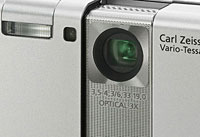
Sony DSC-G1 specifications
Sensor 1/2.5″ Type CCD, 6.0 million effective pixels
Image sizes 2816 x 2112, 2048 x 1536, 1632 x 1224, 640 x 480, 2816 x 1872 (3:2), 1920 x 1080 (16:9)
Movie clips 640 x 480 @30fps, 320 x 240 @ 30fps
File formats JPEG, DPOF, MS Video LV4
Lens Carl Zeiss Vario-Tessar, 3x optical zoom, 38-114mm (35mm equiv), F3.5-4.3
Image stabilisation SuperSteadyShot
Focus AF area modes 9-point
AF assist lamp Yes
Focus distance AF: 50cm
Macro: 8cm (wide) 25cm (tele)
Metering Multi-pattern, Center-weighted, Spot
ISO sensitivity ISO 80 – ISO 1000
Exposure compensation +/-2EV in 1/3EV increments
Exposure bracketing 3 frames @ +/-0.3 / 0.7 / 1.0EV
Shutter speed Auto: 1/4-1/1000, P: 1-inch-1/1000
Slow shutter: 1/6sec or slower
Aperture F3.5-5.6 (wide) F4.3-7.1 (tele)
Modes Auto, Program Auto, Scene
Scene modes Twilight, Twilight Portrait, Landscape, Beach, Snow, Fireworks, High Speed, Shutter, High Sensitivity, Soft Snap, Handheld Twilight
White balance Image Sensor – Auto, Daylight, Cloudy, Fluorescent, Incandescent, Flash
Self timer 2 or 10 sec
Continuous shooting max 7 shots @ 3.3fps
Flash Auto, On, Slow Synch, Off, Red-eye reduction, Auto Daylight Synch
Range: 0.1-2.8m (wide) 0.25-2.2m (tele)
Viewfinder No
LCD monitor 3.5-inch, 921,000 pixels
Connectivity Cradle, USB 2.0, AV out, DC in, WiFi (b/g)
Storage Memory Stick / Pro Duo, 1.86GB internal memory
Power Rechargeable Lithium-ion battery NP-FR1
Weight (no batt) 204 g (7.2 oz)
Dimensions 93.3 x 71.7 x 25.3 mm (3 11/16 x 2 13/16 x 1 in)
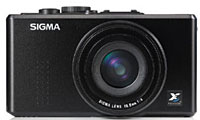 Sigma have announced the full details of their new DP1 camera, a high end point’n’shoot digital camera packing a hefty 14 megapixels resolution with a full size image sensor.
Sigma have announced the full details of their new DP1 camera, a high end point’n’shoot digital camera packing a hefty 14 megapixels resolution with a full size image sensor.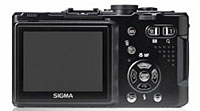 Camera controls
Camera controls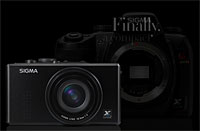 The 28mm fixed lens is disappointingly slow at just f4, but this may be compensated by improved high ISO performance.
The 28mm fixed lens is disappointingly slow at just f4, but this may be compensated by improved high ISO performance.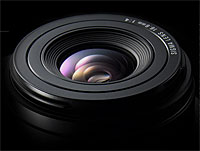 Specifications
Specifications
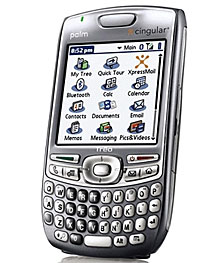 A few months ago Palm shelled out $44 million to Japan’s Access Systems for a perpetual license of the operating system used by Treo smartphones and PDAs, ensuring that current and future Palm handhelds remain compatible with Palm’s Garnet OS.
A few months ago Palm shelled out $44 million to Japan’s Access Systems for a perpetual license of the operating system used by Treo smartphones and PDAs, ensuring that current and future Palm handhelds remain compatible with Palm’s Garnet OS.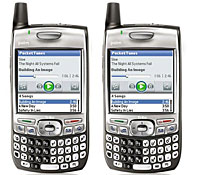 Treo 755p
Treo 755p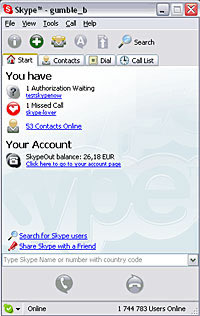 A pretty staggering number, even when you realise that it includes all of the downloads and possibly all upgrades of the software (* We’re in the process of checking this with Skype HQ).
A pretty staggering number, even when you realise that it includes all of the downloads and possibly all upgrades of the software (* We’re in the process of checking this with Skype HQ). Gordon Brown has announced that a new labelling system for media content is in the works, designed to help parents protect their children from dodgy digital content.
Gordon Brown has announced that a new labelling system for media content is in the works, designed to help parents protect their children from dodgy digital content.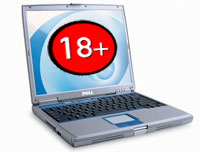 As part of the scheme, Ofcom will introduce common labelling standards covering cinema, TV, radio, computer games and the internet.
As part of the scheme, Ofcom will introduce common labelling standards covering cinema, TV, radio, computer games and the internet.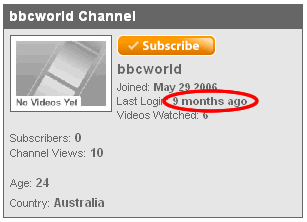 When an important deal like
When an important deal like 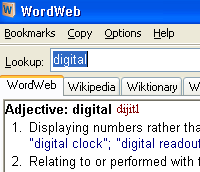 We rather liked the nifty
We rather liked the nifty 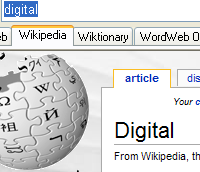 Full Windows Vista support has been bolted on, with the authors claiming that the program now comes with “many thousands of new senses, synonyms and clarifications.”
Full Windows Vista support has been bolted on, with the authors claiming that the program now comes with “many thousands of new senses, synonyms and clarifications.”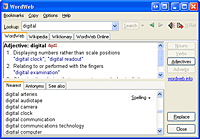
 In the wake of US newspaper
In the wake of US newspaper  The recently relaunched
The recently relaunched 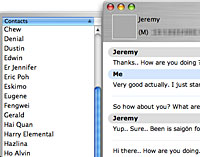 The Palm platform has traditionally enjoyed a lot of support from Mac users who can perhaps relate to the platform’s status as a great working product that isn’t as well known as it should be (or maybe it’s because it’s simply not Windows?!).
The Palm platform has traditionally enjoyed a lot of support from Mac users who can perhaps relate to the platform’s status as a great working product that isn’t as well known as it should be (or maybe it’s because it’s simply not Windows?!). All the messages are searchable and the program offers international language support.
All the messages are searchable and the program offers international language support.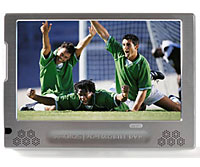 Keen to maintain its position as the Dark Master Of All Things PMP, Archos have announced the latest addition to its Personal Media Player, the 704 Wi-Fi.
Keen to maintain its position as the Dark Master Of All Things PMP, Archos have announced the latest addition to its Personal Media Player, the 704 Wi-Fi.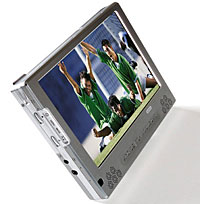 As befits its media player billing, this puppy can play a ton of video formats including MPEG-4, AVI, Divx and WMV video files, and MP3 and WMA audio files (with optional plug-ins for h.264, MPEG-2 MP@ML, and AAC support). There’s also support for PlaysForSure.
As befits its media player billing, this puppy can play a ton of video formats including MPEG-4, AVI, Divx and WMV video files, and MP3 and WMA audio files (with optional plug-ins for h.264, MPEG-2 MP@ML, and AAC support). There’s also support for PlaysForSure.